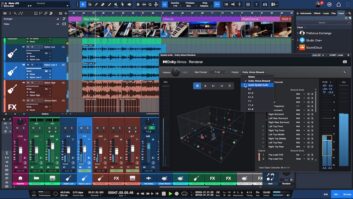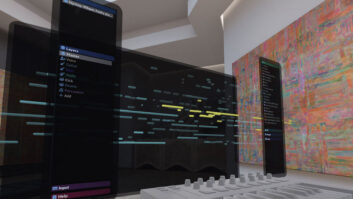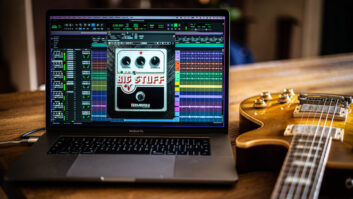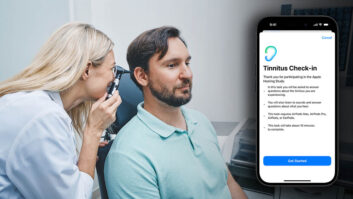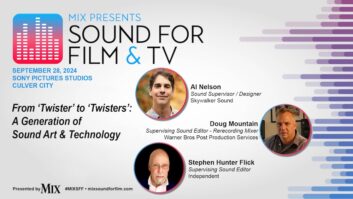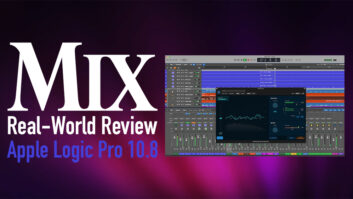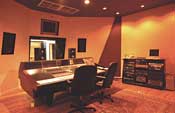
SAE New York’s Neve room
Photo: Herb Dishman
The state of audio education in New York, and more specifically, New York City, just became even more accommodating. SAE Institute (www.sae.edu) has expanded its presence in Manhattan with an attractive new campus in the bustle of mid-town’s Herald Square, bringing a distinctly European mindset and the backing of an international multimedia education brand to one of America’s most talented towns.
SAE’s move to bigger and fresher quarters was made necessary last year when The New York Times bought out the block that held its previous building. The result is an open, airy facility with gently curving interiors that gives potential audio students another good learning option in a city that is home to a steadily increasing number of audio education programs. The complex houses 33 studios/labs/personal workstations, including two flagship rooms with a Neve 88R and SSL 4000 G+, as well as multiple Pro Tools/Mac G5 rooms and MIDI production suites, Mackie HD2 recorders and a Control|24 surround suite with THX-certified monitoring courtesy of Blue Sky International. With a curriculum that includes surround sound and DVD authoring, the school is fully equipped for today’s market.

SAE director Udo Hoppenworth (left) and president Tom Misner at SAE’s new New York City campus
Photo: David Weiss
According to SAE president Tom Misner, the expansion New York City campus reflects a trend that SAE has encountered in several other large cities where it does business. “Growth is fueled simply by demand,” he says. “[Our schools in] Munich, Paris, Amsterdam and Hamburg are all just doubling in size, and to do that, they’re all moving to new premises because they can’t enlarge where they are.
“The reason that there’s more students is because the music business is changing. Big recording studios are needed, but they are dying,” Misner continues. “A guy can go home, buy himself a laptop and start making music — very successfully, too. The smart ones might go to the mixing studio for two days and then they go to the mastering studio, so now it’s just two days in the studio. So that’s the point: We train people on Neve, SSL and Digidesign, because we don’t know where they’ll end up.”
For Misner and Udo Hoppenworth, director of SAE New York, the new campus, which features ninth-story views, lots of natural light and a flow-through design that makes it easy to connect multiple live and control rooms, was a chance to not just give students more space, but an enhanced overall experience. “In New York City, initially we had a different location that was much smaller — half the size,” Misner recalls. “Then the opportunity arose here, and we created a better-looking school. If you’re in a nice facility, you’ll be motivated. It’s important that the student be motivated leaving here because that will make them successful.”
SAE also took the unique needs of the local clientele into account when creating the new facility. “The type of student that New York City attracts is definitely unique,” Misner notes. “The fact that New York City has a special status, besides the audio industry, is reflected here. We have a bigger percentage of international students. The course adapted to the local market — it’s not the same course in London. The New York student wants to be guided. They want to do it on their own time, but they’re into it when you say, ‘Here’s your project. This is what you have to do.’ The London students don’t like that at all. They say, ‘How does it work? I’ll do it myself.’”
Misner continues, “What we were trying to do — moving from the old location to the new location — is expand on the possibility of giving studio time to each individual student, so we made more individual studio rooms and MIDI suites, which we didn’t have before. We have MIDI suites using Emagic Logic and [MOTU] Digital Performer, separate monitoring systems and increased flexibility. We made the place more flexible in terms of working, so we could basically use everything with everything. We have a book for allocating studio time, which makes it very efficient: A student here books the time two to three weeks ahead, so it’s very easy in terms of administration. If you put more energy into this course, you get more out of it. We’re open on Saturday nights, and you can easily double your hours, but you wouldn’t pay double — you just get more out of the program.”
“Regarding the booking system, there’s a minimum that we define that the students have to do, but they can spend lots and lots more time using the studios,” Hoppenworth adds. “A student who’s here can spend more than a normal work week just basically studying. We have labs open from 10 a.m. to 2 a.m.”
Multimedia studies such as filmmaking are also part of the curriculum on many SAE campuses. They’re not available in New York City yet, but they will be. “Adding the film program is definitely on the agenda,” says Hoppenworth. “In designing the facility, we thought ahead to have that space. Basically, we’ll focus even more on individual time by implementing systems where students will have their own laptop all the time. Everything has become more software-based, so instead of booking your workstation, it will be your own laptop supplied by Apple. Even within the audio program itself, there’s a variety of different categories that we teach. In many cases, students initially want to do music recording — they don’t want to know what post-production or mastering is. There are fields within audio where the students don’t know the job possibilities.”
Ultimately, the goal at SAE New York and its 40 other campuses worldwide is to stay on top of the fast-moving developments in multimedia, an imperative Misner has followed since he started the school in 1976 with a Tascam 8-track. “This industry is ongoing change,” he says. “The most gratifying thing is that the students are making it in the industry. The most challenging thing is to continually stay on top, anticipate the market and provide a really good service.”
David Weiss is Mix’s New York editor.

